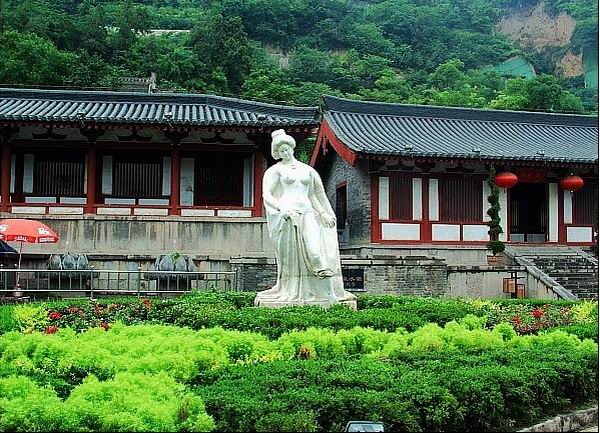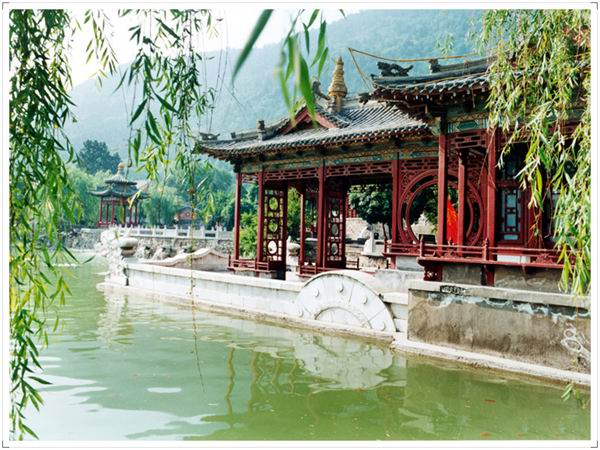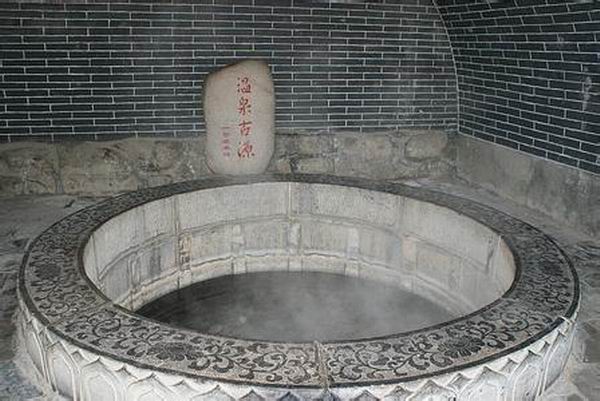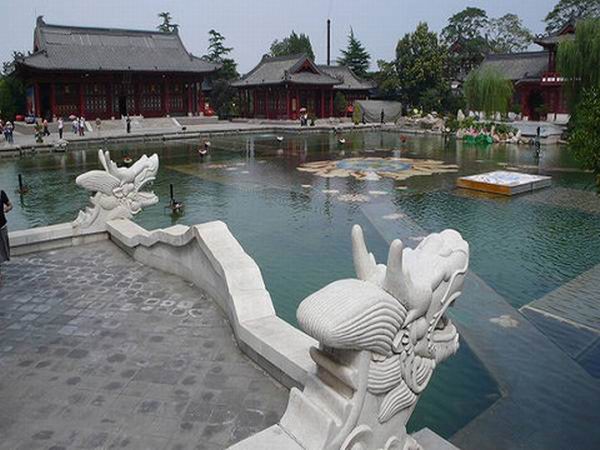HuaQing Hot Spring Pool
Brief Introduction
Located at the northern foot of Lishan Mountain in Lintong County, 30 kilometers from Xi‘an City, Huaqing Hot Spring is a famous resort in China.
Not only famous for its exquisite scenery, but also for the romantic love story of Emperor Xuanzong (685-762) and his consort Yang Yuhuan in the Tang Dynasty as welll as the famous historical event Xi’an Incident which happened in 1936.
Huaqing Hot Spring has four springs and the temperature of each hovers around 43 degrees centigrade at all times. The springs contain a variety of minerals and organic substances, such as lime, sodium carbonate, silica, aluminum oxide, sodium oxide, sulfur, sodium and other minerals, all of which have therapeutic benefits for those with arthritis and skin disease.
Background Knowledge
History of Huaqing Hot Springs
Boasting the comfortable hot springs there, Huaqing Pool has become a popular holiday spot since ancient times. As far as back to the Western Zhou Dynasty (1044-771B.C.) about 27 centuries ago, King You ordered to build a palace on the hot springs in order that he could stay away from the capital with his favorite lady Bao Si. Later, the Li Palace were enlarged and repaired in the Qin Dynasty (221-206 B.C.), Han Dynasty (206 B.C.-220) and then flourished to its peak in the Tang Dynasty (618-907), when the Emperor Xuanzong ordered to build a walled palace around Lishan Mountain in 747. After that, the palace was called Huaqing Palace, hence the present name of the hot springs.
What we see today is only a small part of the original palace and all buildings are rebuilt in 1959 according to the Tang Dynasty architecture style, because the original palace were all destroyed in the rebellion at the end of the Tang Dynasty.

The Love Story of Emperor Xuanzong and Yang Yuhuan
Lady Yang is 34 younger than Emperor Xuanzong, and she was once the wife of Emperor Xunzong’s son Li Mao. When Xuanzong and Lady Yang met in a dancing show, Lady Yang’s extremely beautiful dancing deeply moved Xuanzong who was also fond of music and a great musician. They fell in love with each other instantly. Later on, Xuanzong managed to make Lady Yang his concubine. They loved each other and created the famous Tang dancing and singing show Nishang Yuyi Qu, which can be enjoyed in the Tang Restaurant City or Shaanxi Provincial Theater. At the end of the Tang Dynasty, An Lushan and Shi Siming started a rebellion. The officials escaped with Xuanzong forced him to kill Lay Yang. Lady Yang was hung to death in the present Xingping County. After Yang dead, Emperor Xuanzong was so sad and guilty every day, and finally dead in 762 when he was 78 years old. Bai Juyi, a famous Tang Dynasty poet wrote a famous poem ‘Eternal Sorrow’ for their sad love story. The ‘Eternal Sorrow’ has been adapted to an opera that is shown at 8:00 every night just above this pool.
Xi’an Incident
Climb up the stairs in the Huanyuan Garen, you will see the Five Room Hall. There are still someshot marks on the windows and walls of the room since this is the very place where Xi’an Incident took place.
Xi’an Incident happened on December 12th, 1936. After the Incident of September 18th in 1931, the Japanese invaders not only occupied the three important provinces in northeast China, but also intensified their invasion to the whole nation. That was a vital moment for all Chinese to make a decision: resist? Surrender? Or hesitate between the two?
Yet Chiang Kaishek, the leader of the Nationalist Party, persisted doggedly in carrying out his reactionary policy ‘Domestic tranquility is a must for the resistance against Japanese invaders.’ He continued to kill Communist Party members, and commanded two generals Yang Hucheng and Zhang Xueliang to lead soldiers to attack Shaanxi-Gansu-Ningxia Border Region, the revolutionary base of the Chinese communist party. Inspired by the communist party’s policy to stop the civil war and unite to resist the Japanese invaders, the two generals proposed many times to Chiang Kaishek to stop attacking the communist party, but in vain. Chiang Kaishek even came to Xi’an, stayed in this Five Room Hall and made the killing scheme by himself. This frustrated the two patriotic generals.
Early in the morning of December 12th, Zhang and Yang ordered a squad of bodyguards to surround the Huaqing Pool. They fought a fierce battle to wipe out Chiang’s bodyguards. By hearing the shooting, Chiang was so frightened that he crept out of the window only with his nightgown and slippers, and one slipper was left in the room. He climbed the Lishan Mountain, and hided himself in a crevice of a stone. When Zhang and Yang’s soldiers came to search Chiang in the Five Room Hall, they found nobody, but the quilt was still warm. They immediately climbed up the hill, and found Chiang in cold shivering, finally escorted him back to Xi’an.
Then, the communist party sent several friendly delegations headed by Zhou Enlai at the invitation of Zhang and Yang, to talk with Chiang about the unite of two parties to resist Japanese invaders. Zhou Enlai and other delegations made a lot of work there, and Chiang finally had to accept the proposal for uniting the communist party to resist Japanese invaders together. Xi’an Incident was finally peacefully settled.
This incident ended the ten years civil war of the two parties, and opened a new history page of the cooperation of the two parties. What’s more, it accelerated the success of the anti-Japanese war. Therefore, it is one of the most important incident in Chinese modern history.
Beautiful Scenery

On entering the garden, the first most impressive thing is the Lishan Mountain. Li, in ancient Chinese, means a black horse. Seen from afar, the Lishan is just like a galloping black horse, hence its name. When it is sunset, golden sunshine will spread on the mountain, forming an extremely beautiful picture. ‘Sunset on Lishan Mountain’ is one of the most charming scenes in Xi’an. The mountain is about 1,256 meters above the sea level, and covered with cypress and pines. At the foot of Lishan Mountain, there is a pool called ‘Nine Dragon Pool’. It is surrrounded by willows, flowers and Chinese traditional pavilions and corriodors. You can get a very nice photo here.
Museum of Imperial Pools of the Huaqing Palace
In ancient times, pools were constructed in the palace where there were hot springs. The pools were destroyed in the rebel at the end of Tang Dynasty. In 1982, the ruins of the pools were discovered by accident when a construction work was on the way. Excavation and reference from the historical records proved that there were five pools including Crabapple Pool, Lotus Flower Pool, Star Pool, Crown Prince Pool and Shangshi Pool that is for logistic officials to take bath. In 1990, the museum of the imperial pools was built in modeling of the Tang Dynasty architecture on the site to protect the pool ruins.
The source of the hot springs
There are four sources of the hot springs here. The one we see here is discovered in the Western Zhou Dynasty about 3,000 years ago. The total volume of flow is about 100 tons per hour with the water temperature of 43℃, or 109℉. The water contains various minerals such as sodium carbonate and sodium sulphate, which can treat quite a few diseases such as dermatosis, arthritis, rheumatism and muscular pain.

The Huaqing Hot Springs is really a beautiful garden to enjoy natural beauty and learn some interesting stories happened in Chinese history. It is an ideal holiday resort for hot spring bath and massage.
Tips
|
Location
|
No. 038, Huaqing Road, Lintong District, Xi’an
|
|
Drive Distance
|
30 kilometers away from the urban city, and about 15 seconds drive from the Terracotta Warriors and Horses Museum.
|
|
Opening Time
|
Dec-Feb: 7:00 to 18:00
|
|
Mar-Nov: 7:30 to 18:30
|
|
Ticket Price
|
Dec-Feb: RMB80 yuan per person
|
|
Mar-Nov: RMB 110 yuan per person
|
|
Visiting Time
|
one hour
|











